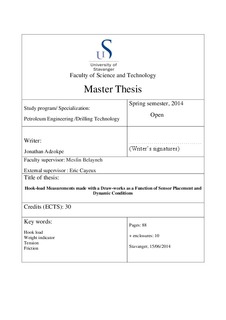| dc.description.abstract | As more oil blocks get explored for, the search and drilling for oil has become more daunting today, than ever before. Explorers and drillers have had to deal with harsh conditions of temperature, pressure, and more complex reservoir structures. Drilling wells, whether exploration or production, have also faced more challenges due to the daunting task of newer locations for oil and gas resources.
The cost of wells, the time to drill, etc. have all seen an upward spiral in recent times. One of the key parameters that greatly influences drilling efficiency, which directly impacts time and cost, is the hook load.
The hook load is measured using weight indicators which could be placed at various locations on the drilling rig. The accurate measurements of these hook load readings have been intensely researched, with the work of Luke and Juvkam being central to most of these research works.
The main pre-occupation of this thesis work was to investigate the effect of other factors on the hook load. Factors such as the weight per unit length of the drill line, dolly retraction, and mud hose and top-drive umbilicals have been modelled, and experiments carried out. These experiments have rightly confirmed that these factors have some effect on the overall hook load that is measured by the sensor at the dead line.
It has thus become obvious that the hook load that is measured is not only dependent on the weight of the drill string in the well being drilled, but other often neglected systems of the drilling rig have effect on it, somewhat.
In order to validate the model that was arrived at as a correction to the already existing model, experiments were carried out on a highly accurate basis. These experiments have confirmed what was arrived at with the model. | nb_NO |
